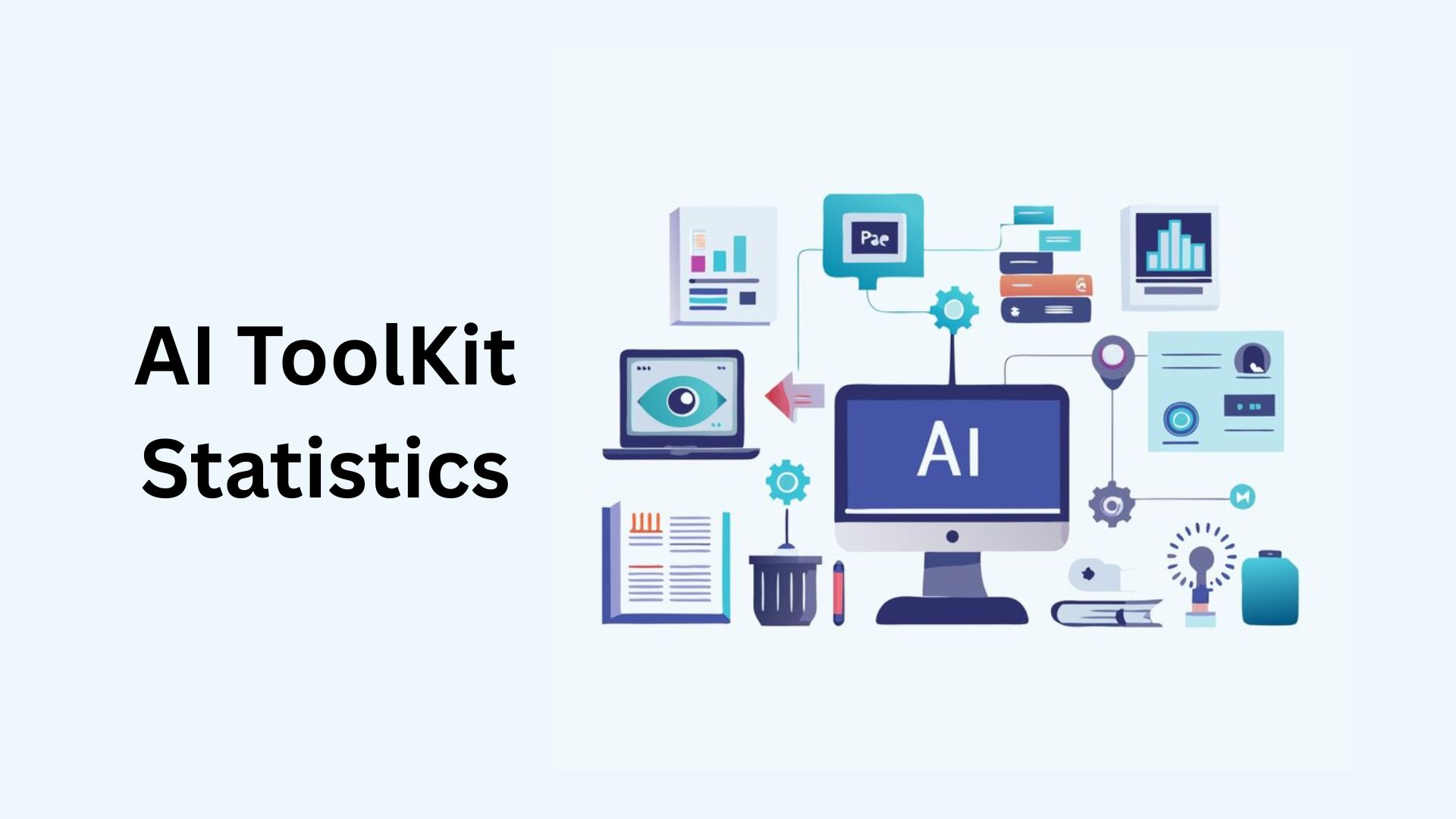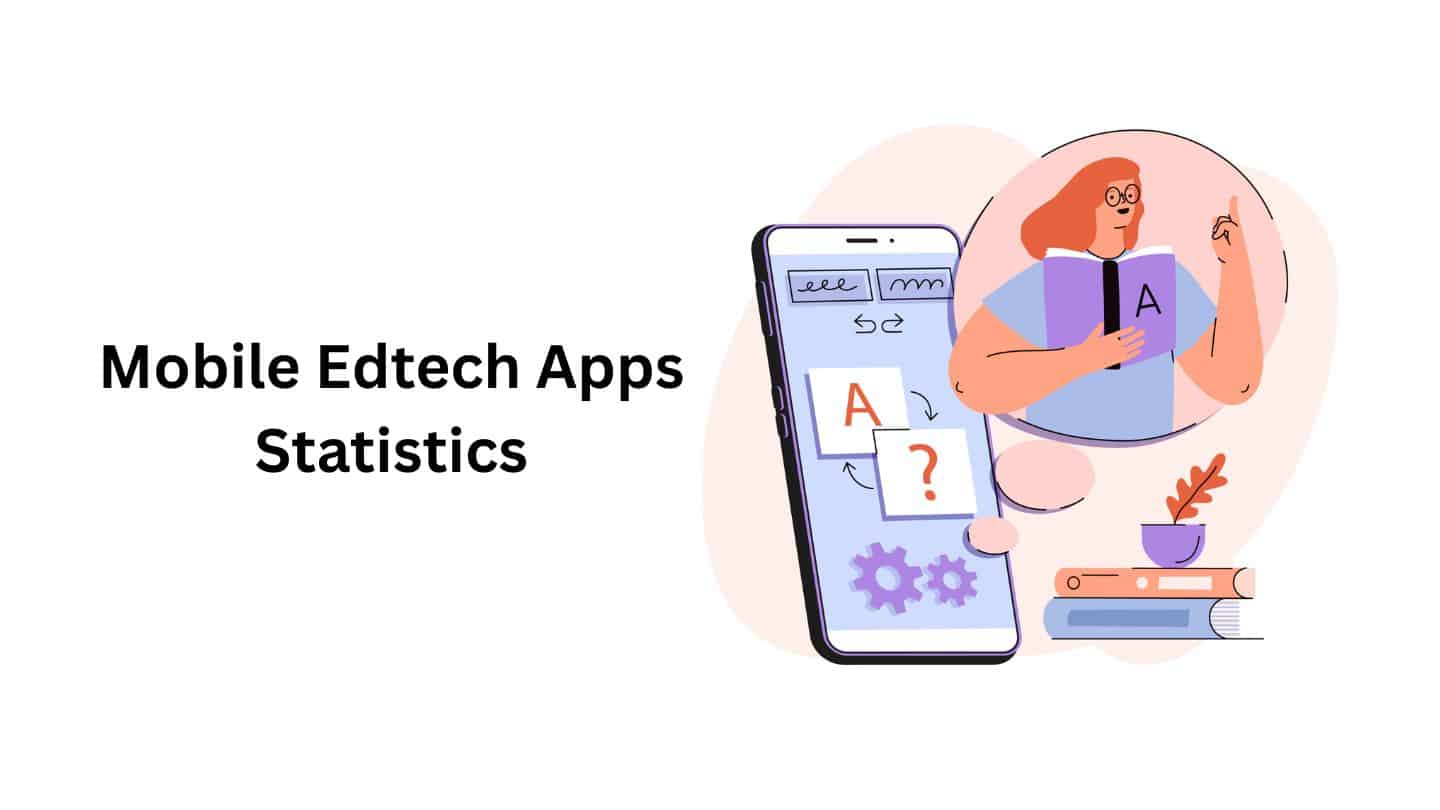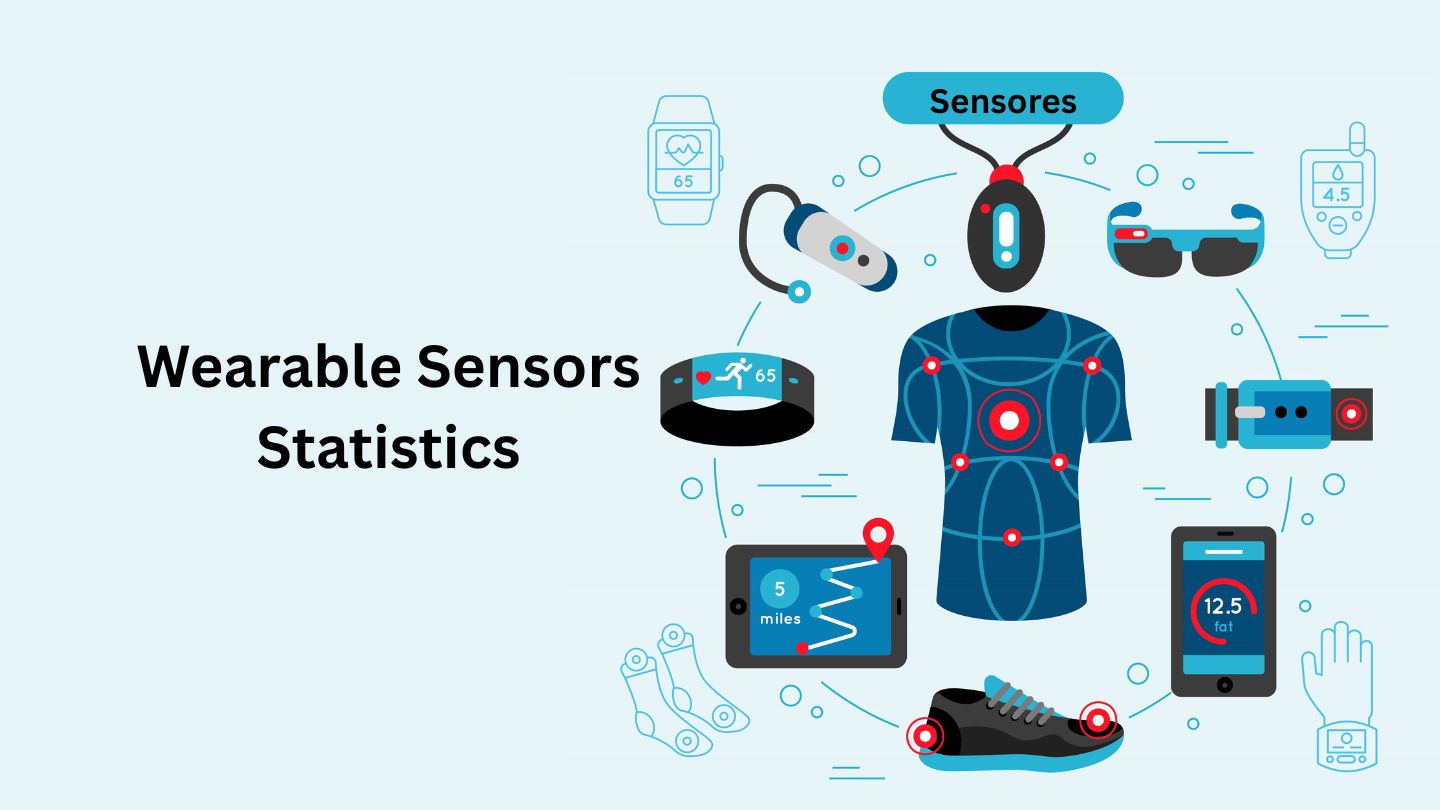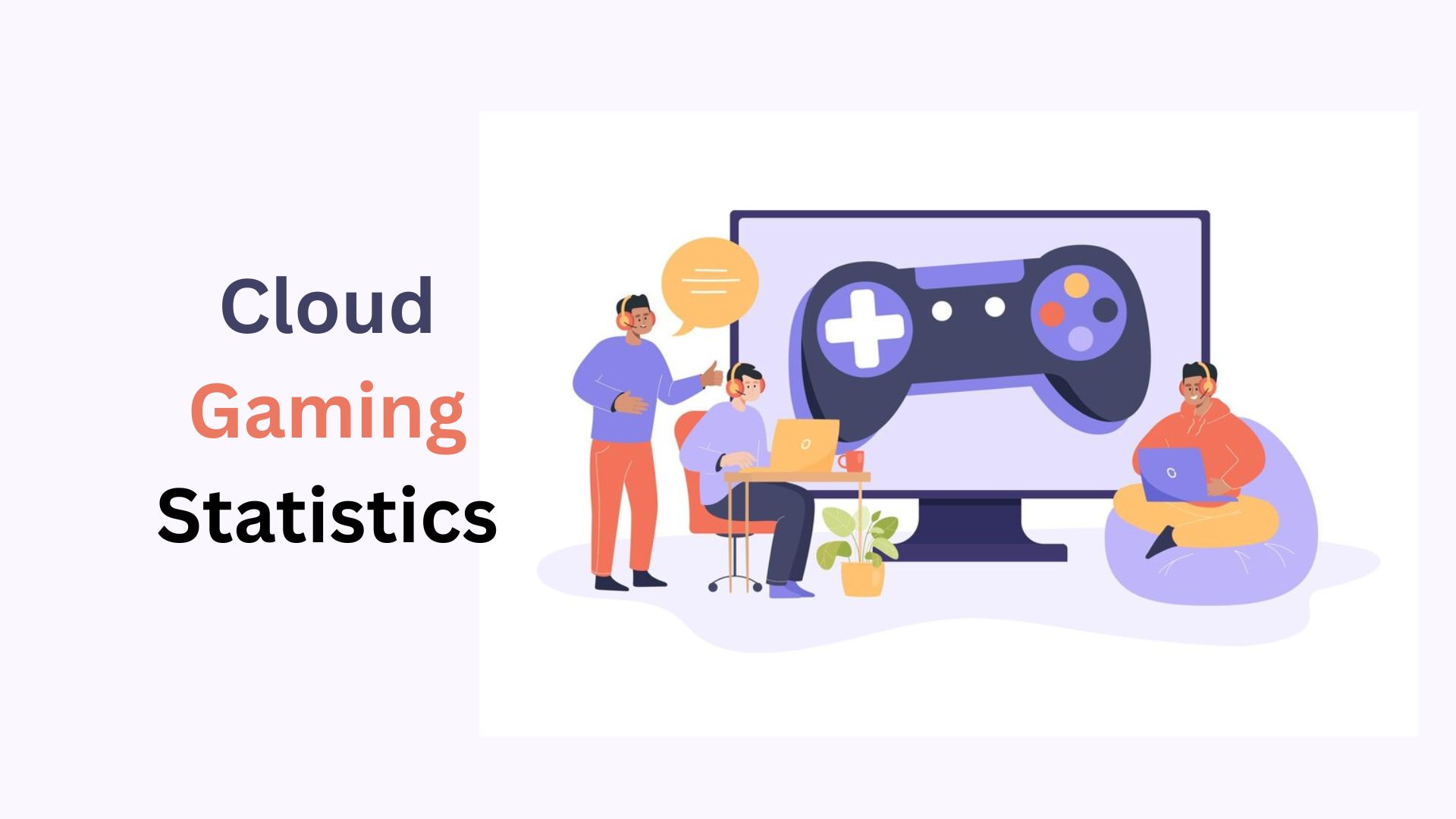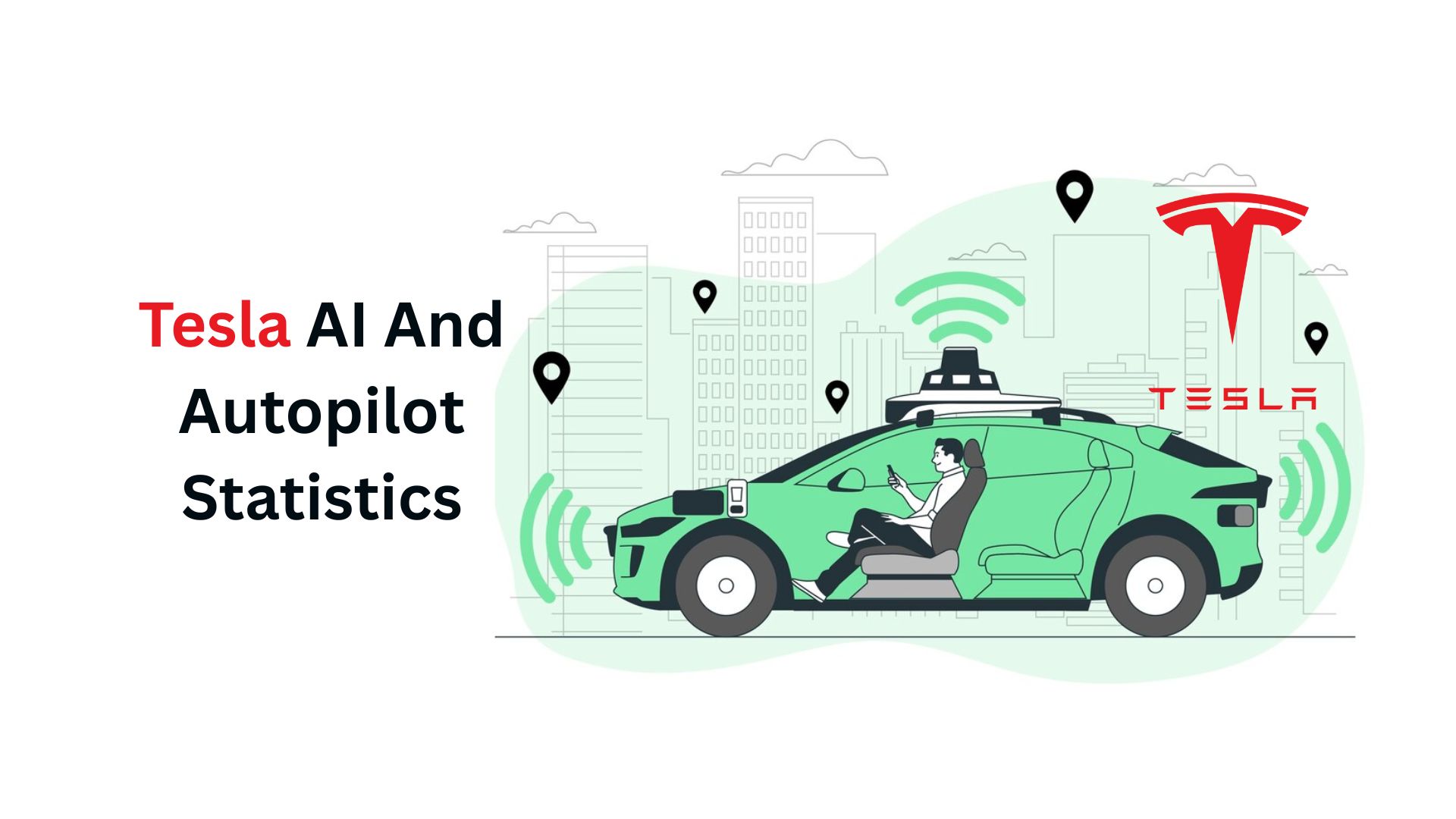NFT Statistics By Market Size, Industries, Demographics and Facts

Updated · Mar 26, 2025


TABLE OF CONTENTS
- Introduction
- Editor’s Choice
- What is NFT?
- NFT Trends 2025
- General NFT Statistics
- Regional NFT Statistics
- Largest NFT Marketplace Statistics By All-Time Sales Volume
- NFT Market Sales Size Statistics 2025
- NFT Market Segmentation Statistics
- NFT Statistics in Different Industries
- NFT in the Art Industry
- NFT Demographics Statistics
- Metaverse NFT Statistics
- NFT Music Statistics
- NFT aaS Statistics
- Ecological Cost of NFTs
- Conclusion
Introduction
NFT Statistics: Non-fungible tokens (NFTs) have become a major trend in the digital world, changing how people buy, sell, and own digital assets. These unique tokens represent digital art, music, virtual items, and more, making them highly valuable. Over the past few years, the NFT market has grown rapidly, attracting artists, investors, and collectors worldwide. Understanding NFT statistics helps in tracking market trends, sales volume, and the most popular collections.
It also gives insight into how NFTs are being used in gaming, entertainment, and business. This article explores key NFT statistics, including market growth, top sales, and future trends, to provide a clear picture of the industry’s current state and its potential for the future.
In this post, I’ve gathered some important data about NFTs to help you understand their current status in 2025.
Editor’s Choice
- NFT Statistics show that the NFT market is expected to generate USD 608.6 million in revenue by 2025.
- By 2025, the average revenue per user in the NFT market is estimated to be USD 52.3.
- Among all countries, the United States is set to lead the market, with an expected revenue of USD 115.2 million in the same duration.
- The number of NFT users is projected to rise to 11.64 million.
- User penetration in the NFT market is forecasted to be 0.15%.
- Meanwhile, in 2024, the global NFT market is expected to generate approximately USD 683.9 million in revenue.
- However, forecasts indicate a decline of 11.01% in 2025, reducing the market size to around USD 608.6 million.
- The number of NFT users worldwide is projected to reach 11.58 million in 2024 and increase slightly to 11.64 million by 2025.
- The average revenue per user ARPU in the NFT market is anticipated to be USD 162.10 in 2024, decreasing to USD 59 by 2025.
- OpenSea remains the largest NFT marketplace globally, boasting a total trading volume of approximately USD 14.68 billion.
- NFT sales reached USD 85.97 million in the first week of October 2024, with 794,763 buyers and 377,711 sellers participating in the market.
- The NFT gaming market is projected to reach USD 0.54 trillion in 2025, with expectations to grow at a Compound Annual Growth Rate (CAGR) of 14.84%, potentially reaching USD 1.08 trillion by 2030.
- Individuals aged 18 to 24 constitute the largest demographic interested in NFTs, accounting for 14% of respondents.
You May Also Like To Read
- Quantum Computing Statistics
- Biometrics Statistics
- Metaverse Statistics
- Virtual Reality Statistics
- Augmented Reality Statistics
- Dark Web Statistics
- Cybersecurity Statistics
- EdTech Statistics
- Artificial Intelligence Statistics
- Cryptocurrency Statistics
What is NFT?
An NFT, or Non-Fungible Token, is a unique digital asset stored on a blockchain, certifying ownership and authenticity of a specific item, such as digital art, music, or virtual real estate. Unlike cryptocurrencies like Bitcoin, which are interchangeable (fungible), each NFT is distinct and cannot be replaced by another, making it non-fungible. This uniqueness has led to their use in representing ownership of digital collectibles and artworks. NFTs have gained significant attention for their role in buying and selling digital art and collectibles, offering a new way for creators to monetize their work.
Features of NFTs:
- NFTs allow users to own digital items like art, music, or virtual real estate. Each NFT is unique and cannot be copied, giving users clear proof of ownership.
- NFTs are stored on blockchain technology, which is a secure and transparent system.
- Creators can limit the number of NFTs they produce, making each item rare. This scarcity can increase the value of the NFT, similar to limited-edition collectibles.
- NFTs use smart contracts, which are self-executing agreements with the terms directly written into code.
- NFTs can be used across different platforms and applications. Depending on compatibility, a virtual item bought as an NFT in one game can be used in another.
NFT Trends 2025
- AI-Curated NFT Collections – AI is being used more to create unique and eye-catching NFT collections that are tailored to users, boosting interaction and keeping users engaged.
- Gaming Tokenization – In the world of gaming, NFTs are being used to represent in-game items, like characters and land. This helps build virtual economies and opens up new possibilities for NFTs in games.
- Integrated NFTs – NFTs are now being combined with regular digital tokens, allowing people to own fractions of NFTs, making them more accessible and affordable for a larger group, thanks to new technology like ERC404.
- Tokenized Real-World Assets – Physical things like real estate and artwork are being turned into digital tokens on the blockchain. This allows more people to invest and makes these assets easier to trade.
- NFTs in Gaming – NFTs are changing the gaming world by allowing players to own their in-game assets truly. This is creating dynamic virtual economies and offering players exciting new gameplay experiences.
- Phygital NFT Fusion
- “Phygital NFTs” connect the digital and physical worlds. These NFTs prove the authenticity of real-world items or experiences using blockchain, giving people fresh ways to collect and interact with physical and digital objects.
- Defi NFT Integration
- NFTs are now being used in decentralized finance (DeFi) systems. This means people can use NFTs for financial activities like loans or mortgages, which adds more ways to use NFTs in everyday finance.
- Metaverse Expansion
- NFTs are essential in creating virtual spaces in the metaverse. Users can buy, sell, and trade virtual properties with NFTs, helping shape these new online worlds.
- Social Media NFT Integration
- Social media platforms are now letting users show off their NFTs, and some are even looking for ways to reward content creators with NFTs for their work.
- Bitcoin-based NFTs (Ordinals)
- Bitcoin-based NFTs, known as Ordinals, allow digital assets to be stored in individual Bitcoin units called satoshis. This gives creators and collectors a new option for using Bitcoin, offering an alternative to other blockchains.
General NFT Statistics
- In 2024, the total value of the global NFT market exceeded USD 193.84 billion.
- NFTs have gained a solid following in the US. So far, 3 million Americans have bought or sold NFTs.
- NFT Statistics stated that almost 95% of NFTs are considered to have no real value.
- By 2028, the number of people using NFTs is expected to reach 35 million.
- The NFT market is expected to make about USD 6 billion in 2023.
- In 2023, the average money earned per NFT user is around USD 114.80.
- In the US, NFT revenue is expected to reach USD 9 million by 2023.
- The percentage of people using NFTs is expected to be 0.2% by the end of both 2023 and 2027.
- By 2027, the number of NFT users is expected to grow to about 19.31 million.
- “The MEG” is the most valuable NFT market, worth over USD 91 million in 2023.
- The Asia-Pacific region holds 43% of the global NFT market share.
- NFT Statistics stated that more than 70% of people in the US still don’t know about NFTs.
- The NFT market is expected to earn USD 9 million in 2024. This growth is mainly due to better blockchain technology, making NFTs safer and easier to use. Another big reason for the market’s growth is the popularity of NFTs in gaming, where players want to own unique in-game items.
- Celebrities like Snoop Dogg and Grimes have also helped increase interest, though their influence is less strong now than it was a few years ago.
- While the NFT market is doing well in 2024, experts believe it will slow down in 2025, with a decline of 11.01% CAGR.
- The US is the top country for NFT sales. The country has many blockchain companies, and people are quick to adopt new tech, including NFTs. This has helped the US generate the most revenue in the NFT market.
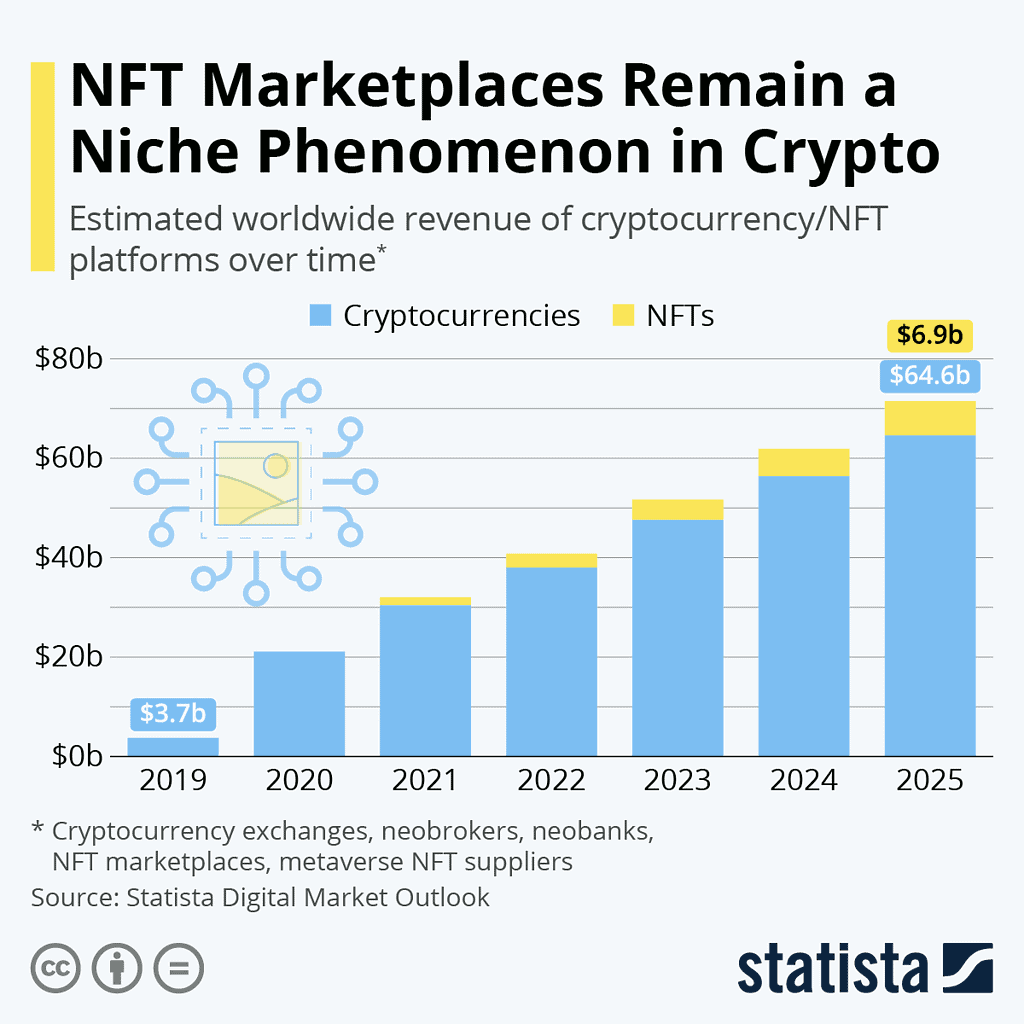
(Source: statista.com)
- Pudgy Penguins is the most valuable NFT collection right now. It has a market value of over 72,000 ETH, and each Pudgy Penguin NFT sells for about 9 ETH. The collection is popular for its cute art and active community, keeping it on top for several years.
- While Pudgy Penguins is doing well, most NFT collections are not valuable.
- NFT Statistics stated that almost 95% of NFT collections have no market value, with 69,795 out of 73,257 collections having a value of 0 ETH.
- Between Q2 and Q3 2023, the number of active wallets decreased by 25%. This decline is due to factors like too many NFTs in the market, lack of interest, and people losing excitement.
- Even with the hype around NFTs, half of all consumers still don’t know what they are, according to YouGov.
- This lack of awareness makes it harder for NFTs to become more popular, showing that more education about NFTs is needed to help people understand them.
- NFTs have gained a solid following in the US. So far, 9.3 million Americans have bought or sold NFTs, showing that many are still interested in digital assets and blockchain technology.
- NFT Statistics stated that about 23% of NFT collectors in the US are millennials. This group is tech-savvy and quick to try new things, making them ideal for adopting NFTs.
- Gen Z didn’t get as involved in NFTs early on, and older people may find blockchain hard to understand, so millennials are leading the way in the NFT market.
Regional NFT Statistics
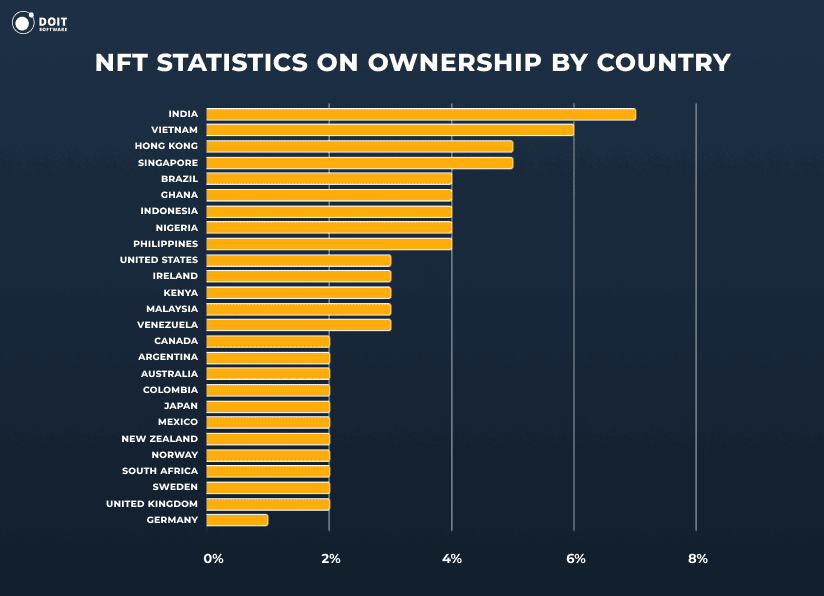
(Source: doit.software)
#1. Africa NFT Statistics
- The NFT market in Africa is predicted to make USD 35.8 million by 2025. This growth is due to rising interest in digital assets across the continent.
- In 2025, each person in Africa’s NFT market is expected to contribute an average of USD 49.1 in revenue, showing that more people are getting involved with NFTs.
- The NFT market in Africa is expected to have 728,900 users by 2025, which shows that more people are starting to use NFTs.
- About 0.05% of Africa’s population is expected to use NFTs in 2025, indicating steady growth in the market.
- NFT Statistics stated that Nigeria is becoming a key player in the NFT market, as local artists and creators are embracing digital ownership and finding new ways to earn money through NFTs.
#2. Asia- NFT
- Asia’s NFT market is expected to generate USD 204.8 million by 2025, showing a rise in interest and investment in digital assets in the region.
- By 2025, each user in Asia’s NFT market is projected to contribute an average of USD 57.1 in revenue, indicating a growing market value.
- The number of NFT users in Asia is expected to grow to 3.59 million by 2025, a significant increase in the number of people participating in the NFT market.
- By 2025, about 0.08% of Asia’s population is likely to use NFTs, indicating a steady rise in the region’s adoption of NFTs.
- NFT Statistics stated that countries like Japan and South Korea are driving the growth of NFTs in Asia, thanks to the growing use of blockchain technology and a cultural interest in owning rare digital items.
#3. Europe NFT Statistics
- The NFT market is predicted to generate USD 174.6 million in 2025, indicating continued growth in the digital asset space.
- The average income of each user in the NFT market is expected to be USD 59.00 by 2025, suggesting that individual users are contributing more to the market.
- The number of people using NFTs is expected to grow to 2.96 million by 2025, indicating an increase in market participation.
- The percentage of people using NFTs is projected to reach 0.35% by 2025, marking a steady rise in adoption.
- Germany is becoming a key player in the NFT market, and there is growing interest in digital artwork. Collectors and investors are also paying more attention to local artists.
#4. Australia & Oceania NFT Statistics
- The NFT market in Australia and Oceania is expected to reach USD 11.1 million in 2025, showing strong potential for growth in this area.
- Each user in the NFT market is predicted to generate an average of USD 60.80 in 2025, reflecting good individual user spending.
- The number of NFT users in Australia and Oceania is expected to increase to 182,700 by 2025, showing a rise in popularity in the region.
- About 0.42% of people in Australia and Oceania are expected to use NFTs by 2025, and the number is expected to grow steadily in the next few years.
- Australia and Oceania are becoming important areas for Indigenous art NFTs, highlighting the region’s cultural heritage and attracting interest from global collectors.
Largest NFT Marketplace Statistics By All-Time Sales Volume
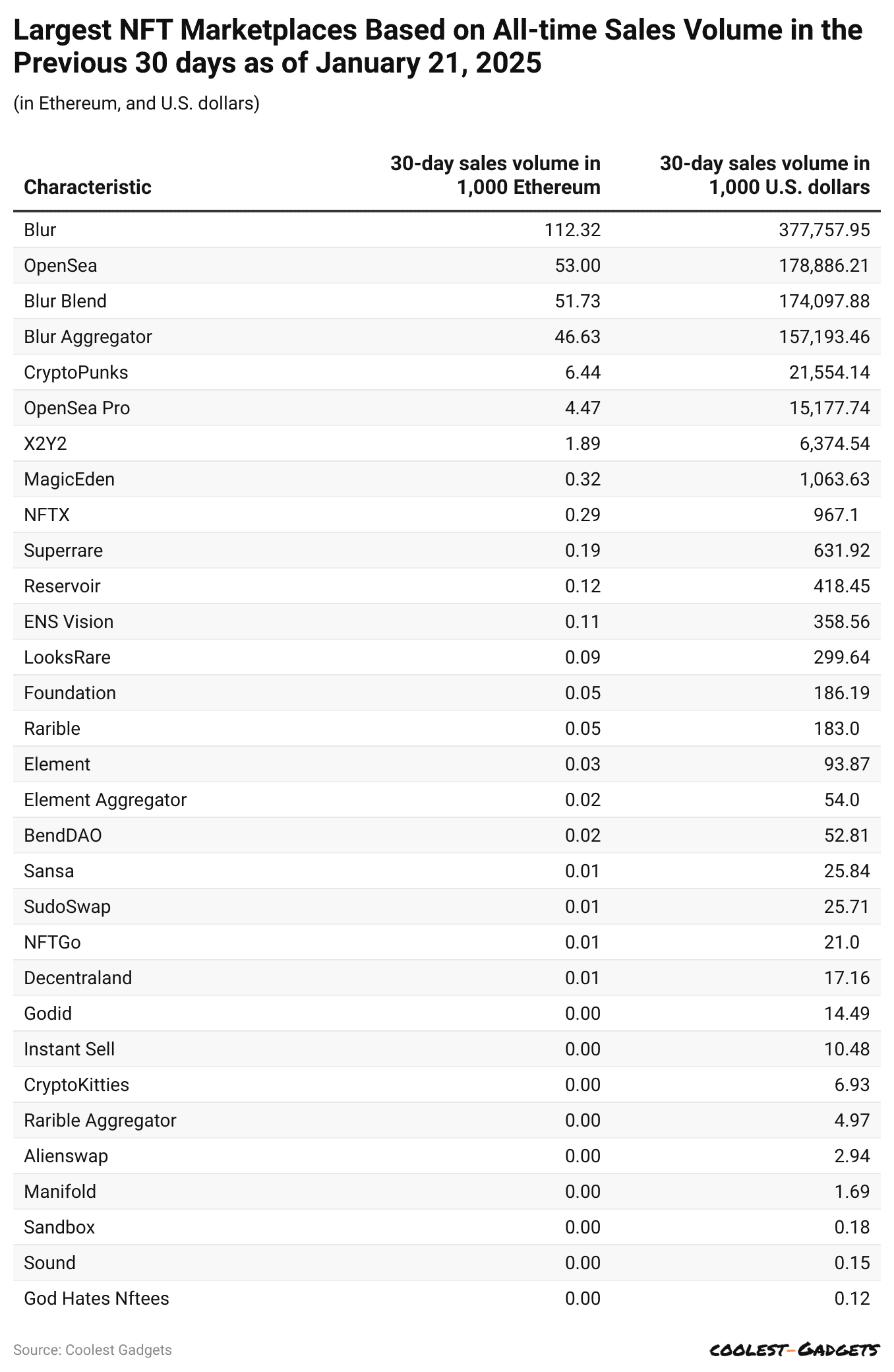
(Reference: statista.com)
NFT Market Sales Size Statistics 2025
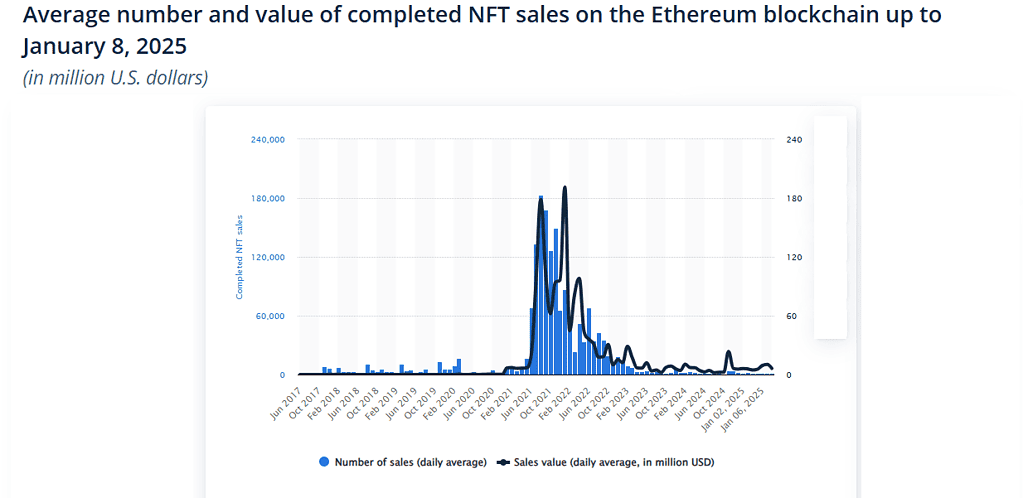
(Source: statista.com)
- In 2024, NFT transactions were much lower compared to the summer of 2021, when many tokens became popular.
- While cryptocurrencies like Bitcoin gained more attention in early 2024, especially after Bitcoin ETFs were approved in the US, the NFT market has been facing challenges.
- In 2024, Solana, a blockchain network linked to NFTs, emerged as a strong player.
- In January 2024, Solana’s monthly sales volume surpassed Ethereum’s, allowing Solana to achieve its highest market share in the overall crypto market.
- NFT Statistics stated that over 50% of NFT sales are below USD 200.
- NFT weekly sales increased dramatically from 100 sales in 2017 to between 15,000 and 50,000 sales in 2023.
- The Nifty Gateway platform had over USD 250 million in sales for 2023, with monthly sales around USD 500,000.
- NBA Top Shot saw transactions totaling over USD 700 million.
- A LeBron James NFT was sold for USD 21.6 million.
- 5 of the top 20 biggest NFTs were from Cryptopunks.
- Collectibles like Cryptopunks and Bored Ape Yacht Club saw the fastest growth in the NFT market but have dropped more than 64% in value since their peak in 2023. Moonbirds saw an even bigger decrease, dropping 92% and 49% year-to-date.
- NFT Statistics stated that OpenSea has over 250,000 active users each month who buy and sell NFTs.
- Due to competition between platforms like Blur and OpenSea, the number of NFT holders hit its lowest point in Q1 of 2023.
- The most expensive NFT ever sold is “The Merge” by artist Pak, which fetched USD 91.8 million.
- The NFT collection with the most transactions is Bored Ape Yacht Club (BAYC), with a total value of USD 2.5 billion in sales. The current floor price for a BAYC NFT is $215,000.
- Cryptopunks is another highly valuable collection, with an estimated total transaction volume of USD 2.1 billion and a floor price of USD 210,000.
- The priciest NFT video is Beeple’s “Crossroads”, which sold for USD 6.6 million.
- The most expensive NFT meme is the Doge meme, which sold for USD 4 million.
- The highest-priced NFT tweet is from Twitter CEO Jack Dorsey, which was sold for USD 2.9 million.
- The priciest NFT virtual land was sold on Axie Infinity for USD 1.5 million.
- The most expensive NFT song sold for USD 1.33 million.
- NFT Statistics stated that the famous Nyan Cat GIF sold for USD 590,000.
NFT Market Segmentation Statistics
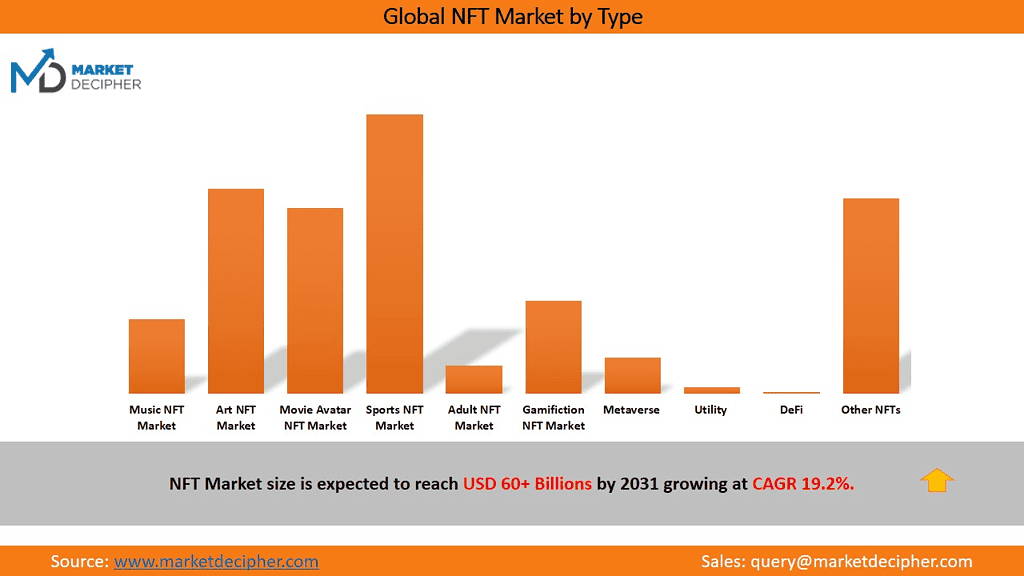
(Source: marketdecipher.com)
#1. NFT Market Share By Type
- The global NFT market is divided into two main categories: digital and physical assets. Right now, digital assets make up more than 55% of the total market share.
- This is because many young people are interested in owning digital items, and platforms like OpenSea and SuperRare are driving the growth of digital NFTs.
- On the other hand, the market for physical assets is expected to grow at a faster pace, with an expected annual growth rate (CAGR) of 34.28%.
- This is due to more people wanting to own physical items, such as paintings and other merchandise.
#2. Market Share By Type of NFT Offering
- NFTs are also split by type of offering, including art, collectibles, gaming assets, music NFTs, real estate, and others.
- Collectibles currently hold the biggest market share at 45%. However, the art sector is expected to grow at a faster rate, with a projected CAGR of 34.26%.
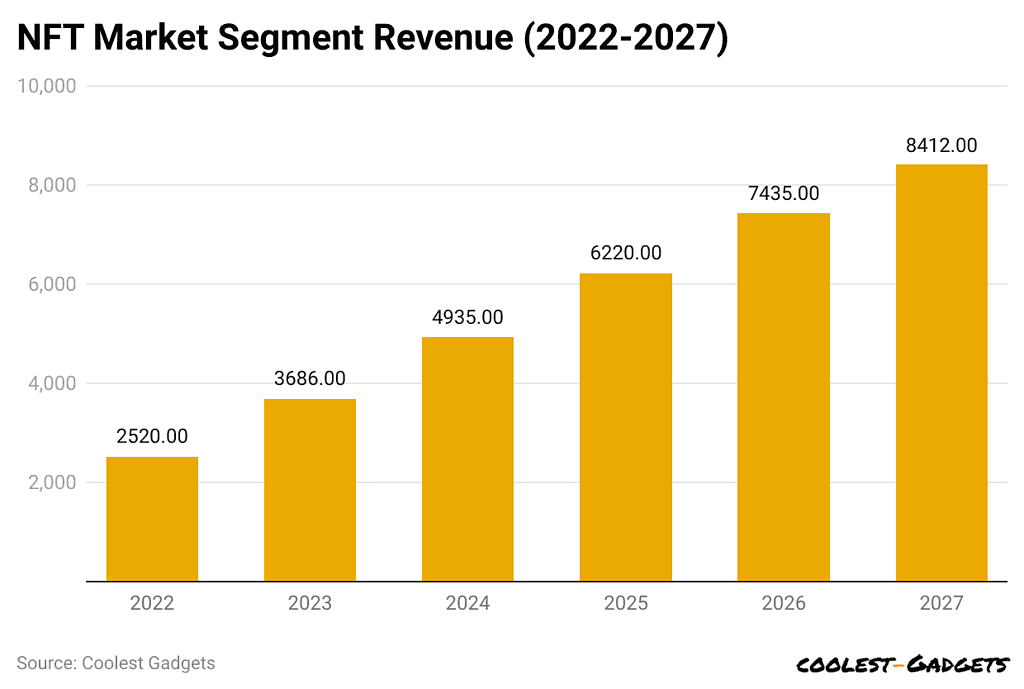
(Reference: appinventiv.com)
#3. Market Share By Type of Platform
- Dedicated NFT marketplaces are expected to lead the market, making up 40.44% of the total share by 2035.
- This segment is projected to grow at a faster rate, with a CAGR of 35.08%. This is due to the easy access these platforms provide for buying and selling NFTs, as well as their specialized features and services.
#4. Market Share By End-User
- Looking at the end-users, the NFT market is divided into collectors, influencers/creators, platform providers, players of NFT-driven games, and others.
- Collectors currently account for 43.3% of the total market revenue and are expected to grow at a higher rate, with a projected CAGR of 34.15%.
- Interestingly, just the top 2% of collectors own 50% of the total NFT market, showing the diversity and strength of the sector.
#5. Market Share By Type of Business
- The NFT market includes both big companies and smaller businesses. However, big companies currently control 60% of the market.
- Major platforms like OpenSea and SuperRare are gaining more users thanks to their focus on art-related NFTs.
- This trend is expected to continue as large enterprises will keep introducing new features to help buyers and sellers.
#6. Market Share By Region
- In terms of geographic regions, Asia leads the NFT market with over 35% of the global share.
- The Philippines stands out as the most successful NFT market in the region, with 32% of Filipinos owning NFTs, which is three times higher than the global average.
- North America is projected to be the fastest-growing market, with an expected CAGR of 34.84%. By 2024, around 9.3 million people (or 4% of the US population) are expected to own NFTs, a significant increase from just 1% in 2021.
NFT Statistics in Different Industries
NFTs started mainly in the art and music world, but now their reach extends to other areas like movies, fashion, and gaming. They’ve also made an impact in industries such as sports, ticket sales, supply chains, and luxury products. Here’s a look at some NFT data in different industries:
NFTs in Gaming
- In 2023, a global survey asked game developers about their interest in NFTs. The results were:
- 7% were very interested in NFTs
- 21% were somewhat interested
- 70% were not interested
- 1% were already using NFTs
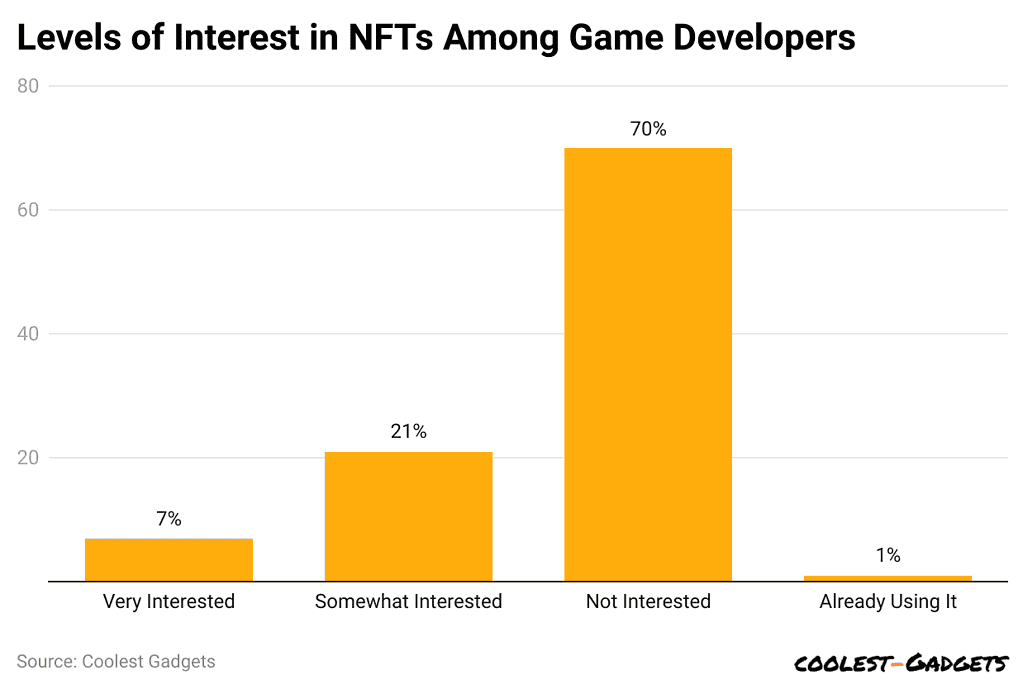
(Reference: doit.software)
- Most developers are not interested in adding NFTs to their projects right now. However, there is still a small group that sees potential in this technology.
- The 7% of developers who are very interested might lead the way for more widespread use of NFTs in the future.
You May Also Like To Read
- Ransomware Statistics
- Smart City Statistics
- 3D Printing Statistics
- iPhone Vs. Android Statistics
- iPhone vs Android Users Statistics
- Laptop Statistics
- Desktops Statistics
NFT in the Art Industry
Next, let’s look at some of the most notable NFTs in the art world.
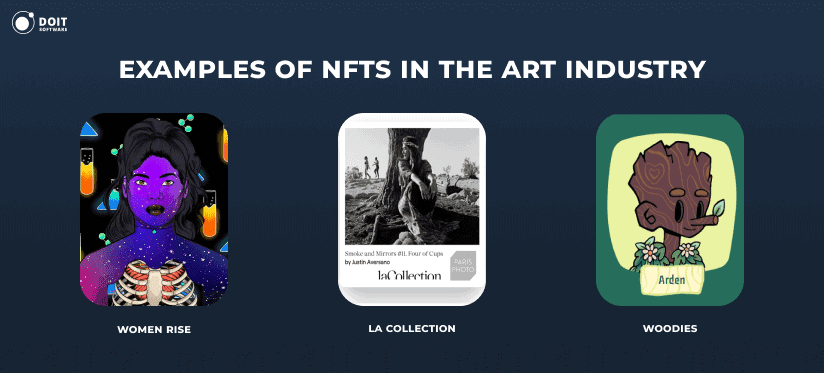
(Source: doit.software)
- “Women Rise” is a collection of NFTs created to honor women worldwide. In the past year, it sold 825 tokens, earning a total of USD 61,901.31.
- “Le Collection” is a French project launched in collaboration with galleries. The platform offers NFTs featuring artwork from both famous and emerging artists. However, there’s no information available on the total number of sales or sales volume.
NFT Statistics on the Music Industry
- The music NFT market is expected to reach USD 15.01 billion by 2031.
- This suggests a potential yearly growth rate (CAGR) of 28.23% from 2021 to 2031.
- Now, let’s explore some musicians who have adopted music NFTs.
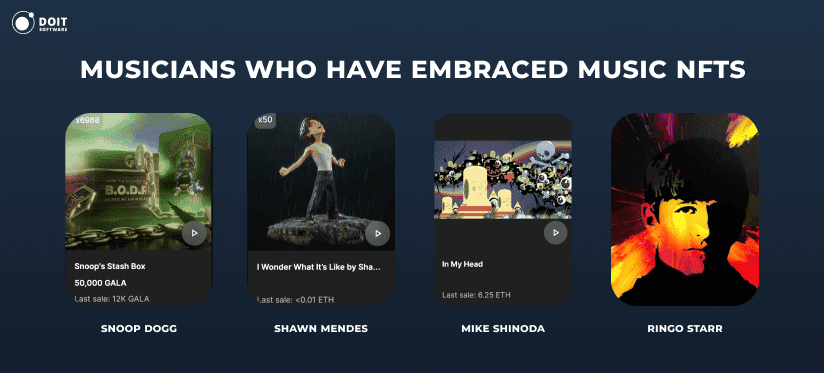
(Source: doit.software)
- Eminem and Snoop Dogg collaborated with Yuga Labs to create a music video featuring their Ape sections. Snoop Dogg sold 25,000 NFT albums, each priced at USD 5,000.
- Shawn Mendes: He entered the world of cryptocurrency through Genies and launched an NFT collection based on his album “Wonder” on OpenSea. He also created digital fashion items.
- Mike Shinoda (Linkin Park): He sold an NFT of a music clip from “Zora” and exclusive artwork NFTs from his project “Happy Endings.”
- Ringo Starr: He collaborated with Julien’s Auction to release 20 NFTs called “The Creative Mind of a Beatle.” These included animated paintings with drum solos, physical artworks, and virtual meet-and-greets.
NFT Demographics Statistics
- A recent survey revealed that one in three American adults collects physical items for fun or investment. Among those collectors, one in four also collects NFTs. Men are three times more likely than women to own NFTs.
- The number of Nigerians owning NFTs is expected to rise from 13.7% to 35.3%. Other countries seeing a big rise in NFT ownership include Peru (14.5%), Venezuela (13.5%), and Colombia (11.9%). In comparison, the US is expected to grow by 3.9%, and the UK by 3.3%.
- NFT Statistics stated that people earning less than USD 25,000 per year are just as likely to invest in NFTs as those earning over USD 150,000.
- However, people with an income between USD 25,000 and USD 150,000 have much less interest, with 94% saying they are not interested in NFTs at all.
- The top buyers are from cities like San Francisco, Los Angeles, San Jose, and San Diego, followed by Austin, Texas.
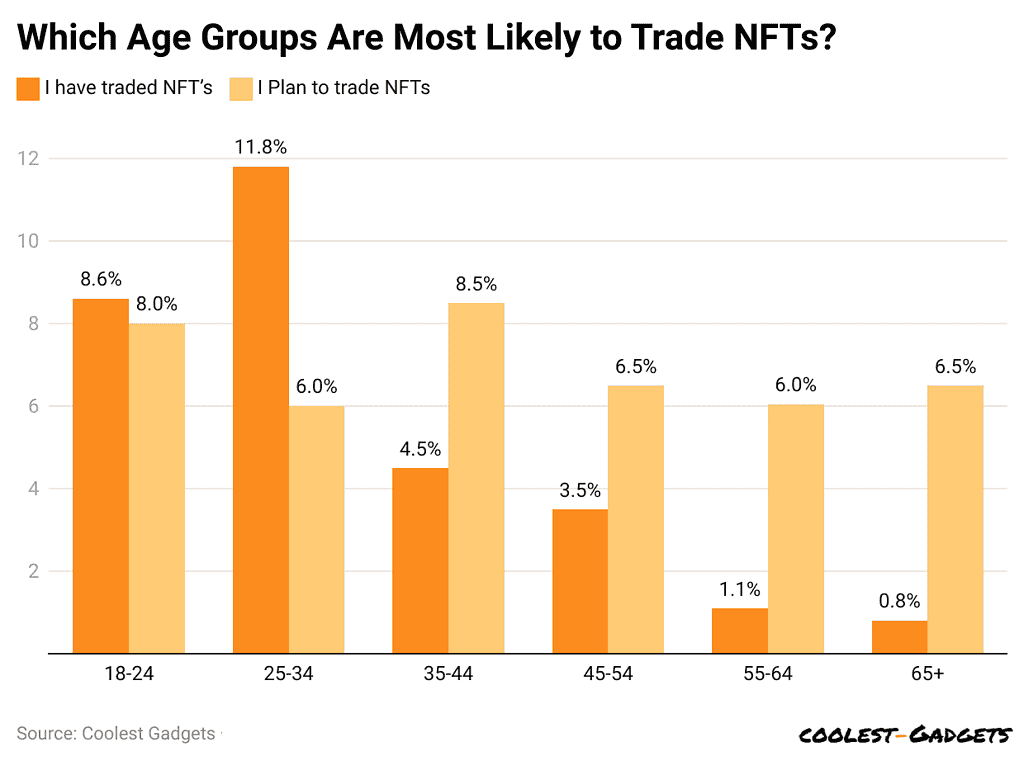
(Reference: learn.bybit.com)
| Age Group | I have traded NFT’s | I plan to trade NFTs |
|
18-24 |
8.6% | 8.0% |
| 25-34 | 11.8% |
6.00% |
|
35-44 |
4.5% | 8.50% |
| 45-54 | 3.50% |
6.50% |
|
55-64 |
1.1% |
6.04% |
| 65+ | 0.8% | 6.50% |
- NFT Statistics stated that almost 8.6% of adults aged 18 to 24 have bought or sold NFTs before, making them the most likely age group to trade NFTs.
- Only 0.8% of Americans aged 65 and older have traded NFTs, and just 6.3% of them are interested in doing so.
- 8% of adults aged 25 to 34 are planning to buy or sell NFTs in the future, making this the age group most likely to get involved with NFTs.
- While only 1.1% of adults aged 55 and older have traded NFTs, 6.4% are interested in buying or selling them in the future.
- NFT Statistics show that almost 37% of NFT owners make less than USD 50,000 a year. This shows that many NFT owners come from lower-income groups. NFTs are not just for the wealthy but are popular among people with different income levels.
- 37% of NFT owners earn between USD 50,000 and USD 150,000 annually. This group represents a large number of middle-income earners involved in the NFT market, showing that people with average incomes are also buying and selling NFTs.
- 26% of NFT owners make more than USD 150,000 a year. The last group consists of people with higher incomes. These individuals are more likely to buy expensive NFTs and play an important role in growing the market.
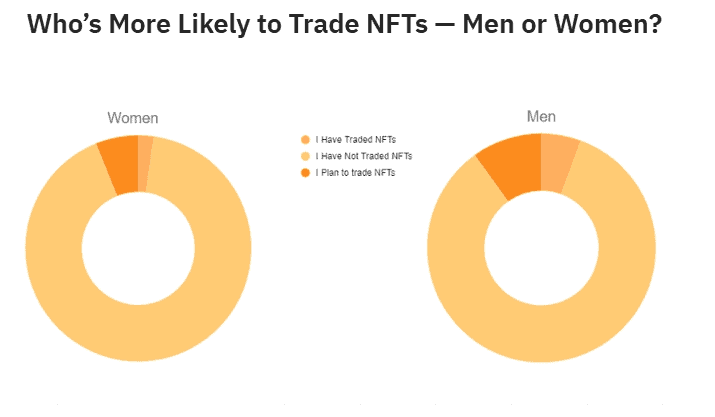
(Source: learn.bybit.com)
- Men in the US are more than twice as likely as women to buy or sell NFTs (5.6% compared to 2.2%).
- Men are also 3.8% more likely than women to plan to trade NFTs in the future (9.9% vs. 6.1%).
- Women are half as likely as men to be interested in trading NFTs (8.3% vs. 15.5%).
- Hawaii comes in second place for NFT purchases, with Nevada following close behind.
- 30% of women in Thailand own NFTs, compared to 23% of men. Thailand is one of the few countries where women have more NFTs than men, with Venezuela being another example (11% of women vs. 10% of men).
- A survey of 28,000 people in 20 countries found that the top five countries with the highest NFT adoption are in Asia (Finder).
- The Philippines leads with 32% of people owning NFTs. Thailand follows with 27%, Malaysia has 24%, the UAE 23%, and Vietnam has 17%.
Metaverse NFT Statistics
- The Global Metaverse NFT Market is projected to grow from USD 335.9 million in 2023 to USD 3,078.7 million by 2033, with a compound annual growth rate (CAGR) of 24.8% during the forecast period from 2024 to 2033.
- In 2023, North America was the leading market, holding 37% of the total market share and generating USD 124.2 million in revenue.
- The desktop segment was the most popular, making up 62% of the market.
- Virtual real estate also played a key role, accounting for 31% of the market share.
- The global metaverse market will grow significantly, reaching USD 2,346.2 billion by 2032, with a compound annual growth rate of 44.4% from 2023 to 2032.
- The number of metaverse users worldwide is predicted to exceed 1.4 billion by 2030, and user penetration will triple to 18%.
- NFT Statistics show that in 2024, around 600 million unique users will engage with metaverse platforms like Roblox, Fortnite, and Minecraft, as well as new test applications.
- Currently, Metaverse NFTs make up 3% of the total NFT market.
- However, wider adoption is likely to boost Metaverse NFT platforms. Meta Reality Labs has invested USD 10 billion to develop the metaverse, and Goldman Sachs sees it as an USD 8 trillion opportunity.
- The term “metaverse” is searched online around 446,000 times each month, showing increasing interest.
NFT Music Statistics
- The global NFT music market is projected to grow from USD 72.02 million in 2023 to USD 1,039.6 million by 2033, with a compound annual growth rate (CAGR) of 30.6% from 2024 to 2033.
- North America is expected to dominate the market with a 40% share in 2023, generating revenue of USD 28.80 million.
- Music tracks were the leading NFT type in 2023, holding a 54% market share.
- Ethereum was the dominant blockchain in the NFT music market in 2023, accounting for 59% of the market share.
- Artists can earn substantial income from NFT sales, with primary sales commissions reaching up to 85% and secondary market royalties at 10%.
- Grimes demonstrated the market’s financial potential by earning over USD 5 million within 20 minutes of her NFT release.
- The NFT music market faces challenges related to platform accessibility, with platforms like SuperRare still in beta, restricting direct artist access.
- Improving platform usability and access mechanisms is critical to attracting more artists and expanding market adoption as the industry matures.
NFT aaS Statistics
- The global NFT-as-a-Service market is projected to grow from USD 1.5 billion in 2023 to USD 34.7 billion by 2033, with a CAGR of 36.9%.
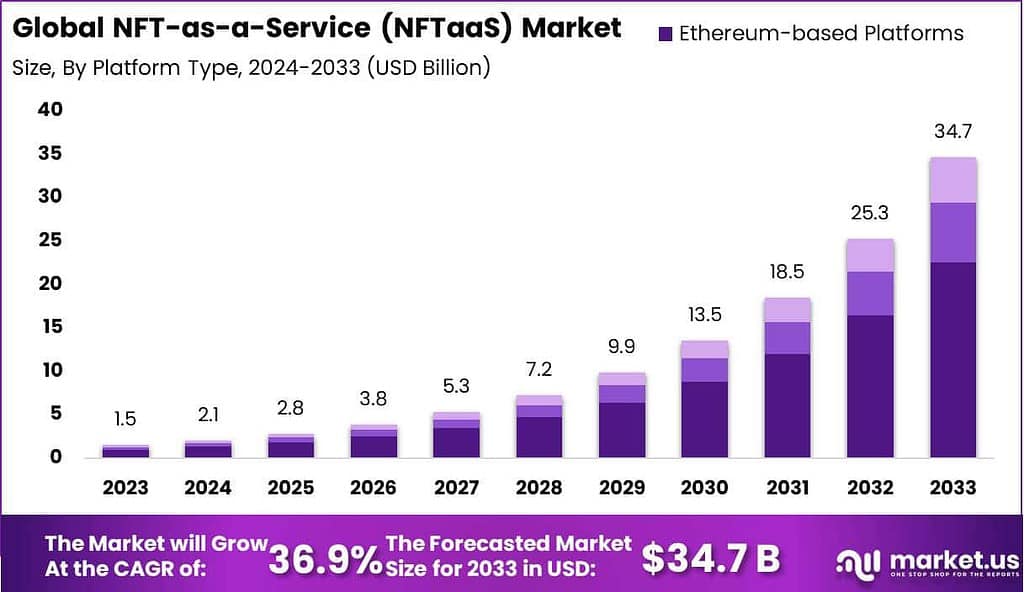
- The NFT market is expected to earn about USD 3,546 million in 2023, with an average of USD 70.46 per user.
- The United States will likely lead, making USD 1,005 million in revenue. OpenSea, a popular NFT marketplace, has nearly 250,000 active traders each month, showing strong user participation.
- The NFT market’s user base is projected to grow to 64.45 million globally by 2027, with user penetration increasing from 0.7% in 2023 to 0.8% by 2027.
- In 2023, the digital art segment held a leading position in the NFTaaS industry, capturing over 36.7% of the market.
- Ethereum-based platforms accounted for more than 65% of the NFTaaS market in 2023, reflecting their dominance in the industry.
- In 2023, North America held the largest share of the NFTaaS market, contributing over 40% of the market value.
- The art NFT segment held a significant position within the NFTaaS industry in 2023, representing more than 32.5% of the market.
- Approximately 23% of millennials in the United States are involved in collecting NFTs, demonstrating strong demographic interest.
- Nigeria is emerging as a leader in NFT adoption, with a projected growth rate of 21.7%, showcasing expanding interest in regions outside traditional Western markets.
- “The Merge,” the most expensive NFT sold to date, was worth USD 91.8 million
Ecological Cost of NFTs
- The Ethereum blockchain uses a lot of energy. Each transaction on Ethereum consumes about 77 kWh of electricity.
- In total, Ethereum’s annual electricity usage is estimated to cost more than $6 billion.
- Ethereum also releases nearly 22 tons of carbon dioxide each year.
- Ethereum 2.0 is designed to reduce its energy use by 99%.
- The environmental impact of one NFT transaction on Ethereum is similar to the average monthly electricity use of a person in Europe.
- In comparison, the Solana blockchain is much more energy-efficient, using only about 0.00051 kWh per transaction.
- Polkadot is even more efficient, with only 0.8 kWh of energy consumed per year.
Conclusion
NFTs (Non-Fungible Tokens) help people trade digital items like art, music, and collectibles. They work on blockchain, which proves ownership and makes them special. NFTs give artists and investors new chances, but there are also problems, like high prices, fraud, and harm to the environment. While they are popular, it’s important to understand the risks before investing. The market is still new, and its future is uncertain. However, NFTs continue to grow in popularity, attracting more creators and buyers.
In the end, NFTs are an exciting digital trend for developers. using NFTs is a chance to engage and keep users involved, as players can earn money while gaming, encouraging them to stay active. We have shed enough light on NFT Statistics through this article.
Sources

Saisuman is a talented content writer with a keen interest in mobile tech, new gadgets, law, and science. She writes articles for websites and newsletters, conducting thorough research for medical professionals. Fluent in five languages, her love for reading and languages led her to a writing career. With a Master’s in Business Administration focusing on Human Resources, Saisuman has worked in HR and with a French international company. In her free time, she enjoys traveling and singing classical songs. At Coolest Gadgets, Saisuman reviews gadgets and analyzes their statistics, making complex information easy for readers to understand.




